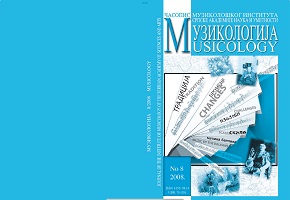Заједничке лествичне особености новије грчке и српске појачке традиције
Common Scale Features of the Recent Greek and Serbian Church Chant Traditions
Author(s): Vesna Sara PenoSubject(s): Music, Eastern Orthodoxy, Sociology of Art
Published by: Muzikološki institut SANU
Keywords: Church singing; ladder; the voice; tune; anastasimatarion; octogenarian; Greek; Serbian; interval; neum script; linear notation; melodic pattern;
Summary/Abstract: This papar is an attempt to show the similarity between the Serbian and Greek Post-Byzantine chanting traditions, especially those which relate to the scale organization of modes. Three teachers and reformers from Constantinople, Chrisantos, Gregorios and Chourmousios, established a fairly firm theoretical system for the first time during the long history of church chant. One of the main results of their reform, beside changes relating to neums, was the assignment of strict sizes to the intervals in the natural tonal system. There are three kinds of natural scales: diatonic, chromatic and encharmonic. They all have their place in the Greek Anastasimatarion chant book, whose first edition was prepared by Petar Peloponesios, and later edited by Ionnes Protopsaltes. The first, first plagal and forth plagal modes are diatonic in each of their melos, with very few exceptions; the second and second plagal are soft and hard chromatic, while the third and varis are encharmonic. It is important to note that the Greek chanter is very conscious of the scale foundation of the melody, so he begins to chant the apechima foremost, the intonation formula that comprehends all indisposed details to enter the adequate mode, i. e. melos. One mode could use one sort of scale for all groups of melodies – melos. However, in some modes there are different melos, whose scale organisation is not equal at all. That means that it is not proper to equate mode with scale, but rather to look for the specific scale’s shape through the melodies that belong to the melos. The absence of formal Serbian church music theory and, especially, the very conservative way in which church melodies are learnt by ear and by heart, has caused significant gaps, which preclude an adequate approach to the essentional principals of Serbian chant. Over the years many Serbian chanters and musicians have noted down church melodies, especially those from the Octoechos, in F or in G, with the key defined as either major or minor. However, it ought to be said that Serbian chanters in the recent past, as well as those who take part in worship today, do not consciously connect the mode, melos or melody with scale progression, but rather with melodic patterns. In other words, neither in the 19th century nor today have Serbian chanters sung characteristic intonation formulae for their respective scale structures, when crossing from one mode to another. The reason this practice has already been mentioned: they learn complete melodies by heart, without thinking about their scale system. In this paper I looked for a proper methodology by which similarities and changes between Greek and Serbian chanting traditions could be discovered. The basis for my comparison was served by the main chant book in two, very popular versions: the Greek Anastasimatarion of Joannes Protopsaltes and the Serbian Octoechos by Stevan Mokranjac. In the analysis it was essential to abstract important data concerning differences between the natural and tempered tone systems, which originated in the natural neumatic and staff notation, respectively. Greek melodies were transcribed, but with additional sharp and flat signs to indicate the natural values of intervals. In contrast, most Serbian melos were transposed into the final tones of the respective Greek hymns. The comparison confirmed my original expectations. The scale progression of Serbian melodies correspond to the natural scale progression of Greek hymns of the first, first plagal – fifth, third, varis – the third plagal and eight modes. They have the main tones which appear at the end of melodic patterns, along with other main tones which represent the framework of the melody. Obvious discrepances are present in the syllabic, so called eirmologic melos of the second, fourth and sixth modes. Serbian scribes of church melodies generally noted these hymns in major (IVth and VIth modes) or major-minor (IInd mode), whereas in neumatic chant soft chromatic is typical for melodies of the same modes (IInd and IInd plagal) and the scale known as legetos hymns (of the IVth mode). But if one tries to chant Serbian melodies of the IInd and VIth modes using the intervals of the chromatic scale, and the melodies of IVth mode with intervals of legetos scale, the resulting sound is surprising. The similarity between the two traditions appears more than obvious. As an excuse for such an experiment, Mokranjac’s testimony about his chanters serve well: “these melodies never give the major third its full height. They sing it a little lower, not because the mode could not encompass a major third but because it goes against the character of these melodies that stand as they are written down here, and as they are sung by all our older experienced singers”. By accepting the staff notation system, Serbian church melodies are graphically fixed in the tempered major-minor system. The process of learning them from notes, especially using intonation from a piano or other temperd instrument, has meant that the various sizes of intervals of the second and third have led to only two sizes in the tempered system. Despite the consequences arising from the use of the staff system, which evidently reflect modern Serbian chant practice, it is a fact that key melodic elements from the neumatic chant tradition of the Orthodox people in the Balkans have been preserved.
Journal: Muzikologija
- Issue Year: 1/2008
- Issue No: 8
- Page Range: 101-125
- Page Count: 25
- Language: Serbian

